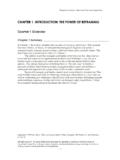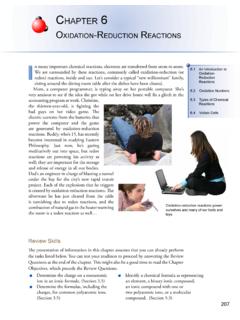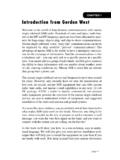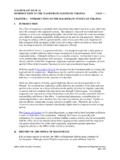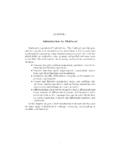Transcription of Chapter 1 NOT FOR SALE OR DISTRIBUTION An …
1 1 ObjectivesAfter completing this Chapter , readers should be able to: Describe the differences between organized and disorganized crime . Explain why defining organized crime is important to law enforcement. Compare the United States definitions of organized crime with those of other countries. Discuss state and federal legislation that address organized ning organized crime as Part of the Process of InvestigationWhat is organized or syndicated crime ? Why is it important for the criminal investiga-tor to identify a target as organized crime ? These questions must be answered before successful strategies, laws, and techniques can be developed for use in any successful investigation of a group of individuals engaged in criminal activity. During the years when J. Edgar Hoover was the Director of the Federal Bureau of Investigation (FBI; 1924 1972), Americans debated whether organized crime actually existed.
2 Later, organized crime became synonymous with the American Mafia. But the true nature and scope of organized crime is the insidious dynamic between those using Chapter 1An introduction to organized CrimeMallory c01 V1 08/04/2011 6:35 PM Jones & Bartlett Learning, LLC. NOT FOR SALE OR DISTRIBUTION . 2053 Jones & Bartlett Learning, LLCNOT FOR SALE OR DISTRIBUTION Jones & Bartlett Learning, LLCNOT FOR SALE OR DISTRIBUTION Jones & Bartlett Learning, LLCNOT FOR SALE OR DISTRIBUTION Jones & Bartlett Learning, LLCNOT FOR SALE OR DISTRIBUTION Jones & Bartlett Learning, LLCNOT FOR SALE OR DISTRIBUTION Jones & Bartlett Learning, LLCNOT FOR SALE OR DISTRIBUTION Jones & Bartlett Learning, LLCNOT FOR SALE OR DISTRIBUTION Jones & Bartlett Learning, LLCNOT FOR SALE OR DISTRIBUTION Jones & Bartlett Learning, LLCNOT FOR SALE OR DISTRIBUTION Jones & Bartlett Learning, LLCNOT FOR SALE OR DISTRIBUTION Jones & Bartlett Learning, LLCNOT FOR SALE OR DISTRIBUTION Jones & Bartlett Learning, LLCNOT FOR SALE OR DISTRIBUTION Jones & Bartlett Learning, LLCNOT FOR SALE OR DISTRIBUTION Jones & Bartlett Learning, LLCNOT FOR SALE OR DISTRIBUTION Jones & Bartlett Learning, LLCNOT FOR SALE OR DISTRIBUTION Jones & Bartlett Learning.
3 LLCNOT FOR SALE OR DISTRIBUTION Jones & Bartlett Learning, LLCNOT FOR SALE OR DISTRIBUTION Jones & Bartlett Learning, LLCNOT FOR SALE OR DISTRIBUTION Jones & Bartlett Learning, LLCNOT FOR SALE OR DISTRIBUTION Jones & Bartlett Learning, LLCNOT FOR SALE OR DISTRIBUTION2 n Chapter 1 An introduction to organized Crimeruthless methods (including corruption and murder) to increase their profits and an insatiable public hungry to purchase illegal goods and crime can be defined by the members and the activities of a group. Although organized crime might potentially be involved in many crimes, what separates individual crime from crimes committed by groups of people is the term organized or organization. Organization has been described as a group of people who cooperate to accomplish objec-tives or goals. Max Weber, known as the father of sociology, examined the elements of an organization. Weber (1947) lists rules, specialization and specialized training, a division of labor, a hierarchy of authority, and continuity or routinization as the parts of a structure necessary for the efficient function of crime has incorporated many successful principles utilized by legitimate business organizations: A unit of command: a superior to whom one is directly responsible The principle of definition: clearly defining authority and responsibility The span of control: a limited number of people controlled by a supervisor The principle of objective: defining the purpose of the organization or the business that is undertaken ( , drugs, murder for hire, extortion, gambling) Insulation and the need-to-know principle: personnel have contact only with their immediate boss and peers A pyramidal structure: orders flow down the hierarchical chart and important decisions are made at the top The principle of specialization.
4 Members of organized crime are experts in a single job function Rules: omerta (vow of silence, never talking to police) and the process of becoming a member of an organized crime groupAs with legitimate organizations, no two organized crime groups are exactly alike. Each group evolves in its own manner. crime organizations require supervision and management to implement strategies that accomplish the goal of profit. Personnel administration is critical to organized crime , just as it is to legitimate business organi-zations. crime organizations remain bureaucratic, with an autocratic leadership that employs punishment for failure, and monetary reward and promotion for success. Many organized crime members also are motivated by a need for esteem, power, and Working Def inition for organized CrimeThe 1986 President s Commission on organized crime concluded that a working Definition must contain characteristics of both the activities and the group.
5 Many coun-tries and states include the structure of the group in their definition. The term working definition is useful to the investigator. Many police departments as well as state and federal Mallory c01 V1 08/04/2011 6:35 PM Jones & Bartlett Learning, LLC. NOT FOR SALE OR DISTRIBUTION . 2053 Jones & Bartlett Learning, LLCNOT FOR SALE OR DISTRIBUTION Jones & Bartlett Learning, LLCNOT FOR SALE OR DISTRIBUTION Jones & Bartlett Learning, LLCNOT FOR SALE OR DISTRIBUTION Jones & Bartlett Learning, LLCNOT FOR SALE OR DISTRIBUTION Jones & Bartlett Learning, LLCNOT FOR SALE OR DISTRIBUTION Jones & Bartlett Learning, LLCNOT FOR SALE OR DISTRIBUTION Jones & Bartlett Learning, LLCNOT FOR SALE OR DISTRIBUTION Jones & Bartlett Learning, LLCNOT FOR SALE OR DISTRIBUTION Jones & Bartlett Learning, LLCNOT FOR SALE OR DISTRIBUTION Jones & Bartlett Learning, LLCNOT FOR SALE OR DISTRIBUTION Jones & Bartlett Learning, LLCNOT FOR SALE OR DISTRIBUTION Jones & Bartlett Learning, LLCNOT FOR SALE OR DISTRIBUTION Jones & Bartlett Learning, LLCNOT FOR SALE OR DISTRIBUTION Jones & Bartlett Learning, LLCNOT FOR SALE OR DISTRIBUTION Jones & Bartlett Learning, LLCNOT FOR SALE OR DISTRIBUTION Jones & Bartlett Learning.
6 LLCNOT FOR SALE OR DISTRIBUTION Jones & Bartlett Learning, LLCNOT FOR SALE OR DISTRIBUTION Jones & Bartlett Learning, LLCNOT FOR SALE OR DISTRIBUTION Jones & Bartlett Learning, LLCNOT FOR SALE OR DISTRIBUTION Jones & Bartlett Learning, LLCNOT FOR SALE OR DISTRIBUTIOND efining organized crime as Part of the Process of Investigation n 3agencies have dedicated resources to the investigation of organized crime . For the inves-tigator, these resources are essential to the success of an organized crime such as personnel, money, equipment, and time are major considerations in an organized crime investigation. Classifying, identifying, or defining a group as a crime organization usually requires an extensive investment by the agency or department a task often made more difficult by a scarcity of resources. Once a group is declared to be engaging in organized crime by a law enforcement entity, multi-agency and federal sup-port is likely to become available.
7 The original case officer or agent may lose much control over the direction of the case or even be directed to go back to his or her normal duties, and allow the major case squad or agency to take charge of the case. Ideally, the supervi-sors would allow the originating officer or agent to be a part of the investigative team. Because special equipment and technology (such as electronic eavesdropping, remote sensing, and night or low-light vision equipment) are very expensive, however, use of these resources will most likely be handled by major case squads or federal or state agencies. Money is certainly the major factor in informant development, overtime pay, and use of special vehicles. These investigations may continue for years and require large numbers of officers and staff. It is easy to understand why organized crime investigations are not small support unit operations with limited resources. Therefore, the investigator must understand thoroughly and meticulously articulate why a group meets the organized crime definition to obtain the resources needed for a successful of organized CrimeThe definition of organized crime varies from agency to agency, from federal to state, and from state to state.
8 An investigator must be sure to use the same definition employed by the jurisdiction or agency in which the case is worked. Each element of the statute or definition must be articulated clearly to ensure the necessary resources and investiga-tive support from the proper agencies are obtained. Defining organized crime accurately also will help in determining solutions for unique problems arising from a long-term and complex investigation. These cases often require long-sitting grand juries, infor-mant protection, special prosecutors, extensive undercover operations, and extraordinary surveillance is important for investigators and resource allocators to agree upon a definition of organized crime when distinguishing it from other criminal activity. A well-defined problem can link an initial investigation to the current evolution of organized crime . The group in question may be a transnational or even international criminal organization requiring international cooperation and assistance.
9 The proper definition refers to acts that are both mala in se and mala prohibita, and includes detailed information about how these activities became organized . The investigator must have an understanding of not only the academic definitions of these issues, but also the legal definitions. Finding a comprehensive definition of organized crime is difficult and requires the investigator to synthesize definitions from both academia and the legal community. Mallory c01 V1 08/04/2011 6:35 PM Jones & Bartlett Learning, LLC. NOT FOR SALE OR DISTRIBUTION . 2053 Jones & Bartlett Learning, LLCNOT FOR SALE OR DISTRIBUTION Jones & Bartlett Learning, LLCNOT FOR SALE OR DISTRIBUTION Jones & Bartlett Learning, LLCNOT FOR SALE OR DISTRIBUTION Jones & Bartlett Learning, LLCNOT FOR SALE OR DISTRIBUTION Jones & Bartlett Learning, LLCNOT FOR SALE OR DISTRIBUTION Jones & Bartlett Learning, LLCNOT FOR SALE OR DISTRIBUTION Jones & Bartlett Learning, LLCNOT FOR SALE OR DISTRIBUTION Jones & Bartlett Learning, LLCNOT FOR SALE OR DISTRIBUTION Jones & Bartlett Learning, LLCNOT FOR SALE OR DISTRIBUTION Jones & Bartlett Learning, LLCNOT FOR SALE OR DISTRIBUTION Jones & Bartlett Learning, LLCNOT FOR SALE OR DISTRIBUTION Jones & Bartlett Learning, LLCNOT FOR SALE OR DISTRIBUTION Jones & Bartlett Learning, LLCNOT FOR SALE OR DISTRIBUTION Jones & Bartlett Learning, LLCNOT FOR SALE OR DISTRIBUTION Jones & Bartlett Learning, LLCNOT FOR SALE OR DISTRIBUTION Jones & Bartlett Learning.
10 LLCNOT FOR SALE OR DISTRIBUTION Jones & Bartlett Learning, LLCNOT FOR SALE OR DISTRIBUTION Jones & Bartlett Learning, LLCNOT FOR SALE OR DISTRIBUTION Jones & Bartlett Learning, LLCNOT FOR SALE OR DISTRIBUTION Jones & Bartlett Learning, LLCNOT FOR SALE OR DISTRIBUTION4 n Chapter 1 An introduction to organized CrimeThere are also differences in world perceptions of organized crime (Albanese, Das, and Verma, 2003). If investigations are conducted outside the United States, knowing the other country s legal and academic definitions of organized crime is essential for obtain-ing assistance from the foreign advantages of synthesizing definitions of organized crime are as follows: Develops strategies and techniques for effective investigation Gains appropriate resource allocation to complete a long-term investigation Obtains cooperation and assistance regionally, nationally, and internationally Increases the investigator s understanding of the particular criminal group Prepares the investigator to address the sophistication, activities, and structures of organized crime Increases the understanding of the motivations that drive those involved in both case strategy and the judicial process Copes with the ever-present aspect of corruption Develops proactive solutions to prevent organized crime from becoming involved or controlling legal enterprises Predicts future organized crime trends and activitiesDefinitions provide understanding and often lead to effective solutions to problems that arise during the investigation.










